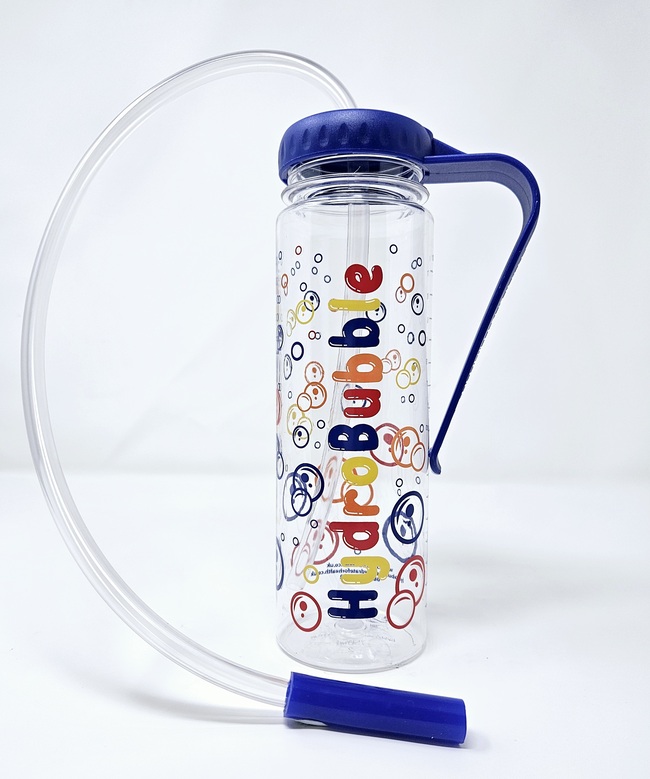Last Updated on: 15th May 2024, 11:35 am
The Cystic Fibrosis Team at South Warwickshire University NHS Foundation Trust and University Hospitals Coventry and Warwickshire NHS Trust have collaborated with Hydrate for Health to introduce HydroBubble, a cutting-edge device designed to transform the care of respiratory patients.
Since its rollout in Coventry and Warwickshire in April 2024, HydroBubble, which is specifically targeted to aid children suffering from Cystic Fibrosis, has garnered extensive praise from both users and their families.
Yasmin Hussaini, Jane White, and Naomi Parsons of the Cystic Fibrosis Team were instrumental in the creation of HydroBubble, driven by their vision to enhance the delivery of a vital NHS treatment.
Back in August 2023, the trio proactively contacted Mark Moran MBE, CEO of Hydrate for Health, to inquire about adapting one of Hydrate for Health’s products. The goal was to create a more sustainable and cost-effective solution to traditional methods of delivering Bubble PEP (Positive Expiratory Pressure) for chest physiotherapy—a technique where patients blow bubbles into water to clear secretions (phlegm/sputum) from their lungs. Following agreement from Hydrate for Health and the subsequent adaptations made, the innovative HydroBubble was created.
The groundbreaking device keeps your airways open by producing vibrations in the lungs to help loosen and move secretions. This, in turn, moves secretions up towards the larger airways, where a huff or a cough can clear them. By removing secretions, it reduces the risk of infections. Healthcare professionals advise patients on how much water to put into a HydroBubble and guide them on the correct techniques and frequency of use.

Bubble PEP physiotherapy is traditionally administered using a 1-litre bottle of sterile water and suction tubing. However, this method is costly and results in significant waste, with the equipment challenging to store and dispose of.
The simple but highly effective HydroBubble addresses these challenges. The device is:
- Reusable and sustainable: HydroBubble is entirely reusable, aligning with the NHS’ commitment to achieving net zero emissions. It significantly reduces waste and environmental impact.
- Cost-effective: HydroBubble is a more affordable alternative to existing PEP devices, ensuring cost savings without compromising quality or effectiveness.
- User-friendly: HydroBubble can be easily held or hung, enhancing patient comfort and safety during therapy sessions.
- Easy to clean and maintain: The device is dishwasher safe and equipped with a flexible tube cleaning brush; HydroBubble simplifies maintenance and ensures optimal hygiene standards.
In addition to the sustainability and cost benefits, the device makes chest physiotherapy appointments fun for children, which helps to improve up take. Furthermore, its versatility makes it suitable for various respiratory conditions requiring Bubble PEP treatment.
Feedback has been extremely positive, with families delighted that there is now a dedicated and fun device to support their children with Cystic Fibrosis.
Rebecca Bott, Mother of Ivan Wright – a Cystic Fibrosis patient, said: “The device is really simple and effective, and it makes chest physiotherapy fun for Ivan.”
“He can already drink by himself, so HydroBubble is simple for him to use by himself.”
Yasmin Hussaini and Jane White from the Cystic Fibrosis Team said: “Children with Cystic Fibrosis need to do chest physiotherapy every day, which they can find onerous. We want to help keep their lungs as healthy as possible, and one way we can do this is by using Bubble PEP.
“The traditional Bubble PEP device consists of a bottle and tubing. It is complex to clean and challenging for our younger patients to use without the aid of an adult. It also creates a huge amount of plastic waste on our wards, as the device needs to be changed weekly. Therefore, we teamed up with Mark Moran, MBE from Hydrate for Health and developed the HydroBubble, which ticked all our boxes.
“We have been using HydroBubble with our Cystic Fibrosis toddlers and children. The device, which our children use twice daily for chest physiotherapy and think is great fun, can be conveniently used indoors, outdoors or on the go.
“The HydroBubble can also be used by adults and children who suffer with extra secretions, as well as people who have been diagnosed with a chronic lung condition such as COPD and Bronchiectasis.”
Maggie Hufton, UHCW Consultant Paediatrician, said: “Airway clearance is a vital part of paediatric Cystic Fibrosis care, and we are so proud to be part of this exciting development.
“We have been trialling it on the ward to improve airway clearance for children with pneumonia and long-term respiratory conditions to aid quicker recovery and reduce length of stay. The device is colourful and easy to use, and our younger patients love using it.”
Further information:
For further clinical information, please contact communications@swft.nhs.uk.
For additional product information or purchasing inquiries:
- NHS Supply chain code: GTV85391
- Amazon: search ‘HydroBubble’
- Contact: hydrobubble@hydrateforhealth.co.uk | visit: www.HydroBubble.co.uk | Telephone: 0800 292 2382









